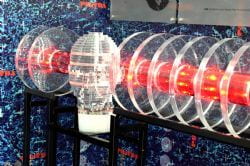World-first Proton CT images create a new vision for cancer treatment
11 May 2017
An international team of scientists has produced the world’s first computerised tomography (CT) images of biological tissue using protons – a momentous step towards improving the quality and feasibility of Proton Therapy for cancer sufferers around the world. The ground-breaking work means that detailed three-dimensional images of a patient’s anatomy can now be created using […]

 An international team of scientists has produced the world’s first computerised tomography (CT) images of biological tissue using protons – a momentous step towards improving the quality and feasibility of Proton Therapy for cancer sufferers around the world.
An international team of scientists has produced the world’s first computerised tomography (CT) images of biological tissue using protons – a momentous step towards improving the quality and feasibility of Proton Therapy for cancer sufferers around the world.
The ground-breaking work means that detailed three-dimensional images of a patient’s anatomy can now be created using protons rather than x-rays, and this will make Proton Therapy a more viable option for millions of cancer patients.
Proton Therapy is a new form of radiotherapy which is rapidly growing in importance as a means to treat difficult tumours and provide treatment for children and young people who have cancer. In the UK, two NHS Proton Therapy Centres are set to open within the next two years, in London and Manchester.
By using protons to create CT images of a patient’s anatomy and tumour, scientists and doctors will now be able to more accurately target the tumour itself and ensure that much less radiation is deposited in the surrounding healthy tissue.
This major breakthrough was achieved by the international PRaVDA consortium, led by Distinguished Professor of Image Engineering Nigel Allinson MBE at the University of Lincoln, UK. His team has been working in the Proton Therapy facility at the iThemba LABS, South Africa, using the South African National Cyclotron – a type of particle accelerator – and they are the first in the world to produce clinical-quality Proton CT imagery.
“To produce these Proton CT images, we built a unique medical imaging platform which uses the same high energy particles that are used to destroy a tumour during Proton Therapy treatment,” explained Professor Allinson. “Like x-rays, protons can penetrate tissue to reach deep tumours. However, compared to x-rays, protons cause less damage to healthy tissue in front of the tumour, and no damage at all to healthy tissue lying behind, which greatly reduces the side effects of radiation therapy.
“The images we have created are in fact of a humble lamb chop, but they highlight the fantastic potential for using Proton CT images to aid cancer treatment in the very near future – as part as the planning process, as well as during and after treatments.
“Proton Therapy is likely to become the preferred radiotherapy method for most childhood cancers, as the unwanted exposure to radiation of healthy tissue is much reduced, and so therefore is the risk of second cancers later in life. Having the ability to administer a high dose in a small region is the main underlying advantage of Proton Therapy, however accurate planning is absolutely essential to ensure that the dose does not miss the target tumour.”
The team has compared their first Proton CT image with a conventional x-ray CT. Although the Proton CT is currently slightly blurrier than the x-ray image, it shows exactly how protons interact with tissues – the same way that the treatment protons do.
Currently in Proton Therapy, there is a significant degree of uncertainty in the range and accuracy of protons during treatment. If planned using x-ray CT images, there could be a discrepancy of 3-5% in terms of where the proton beam hits and releases its energy, destroying cells. With proton CT images, this uncertainty is reduced to less than 1%.
PRaVDA has recorded the lowest ever levels of uncertainty in the relative stopping power of protons when tested on a range of tissue surrogates. The relative stopping power of protons is the key parameter in being able to plan radiotherapy treatments accurately.
In addition, the PRaVDA team has discovered that there are a number of measurable parameters of protons as they pass through the patient, which will produce a set of complementary CT images. This finding opens up a totally new medical imaging field – one that will be exploited in the next generation of PRaVDA’s unique medical imaging instrument.
This technology represents one of the most complex medical instruments ever developed, as imaging with protons is so challenging. Millions of protons make up a single image and each particle has to be individually tracked from the point it enters the patient to the point where it leaves.
The PRaVDA consortium, funded by a £1.8 million translation grant from the Wellcome Trust and led by the University of Lincoln, consists of five UK universities, four UK NHS Trusts and Foundation Trusts, University of Cape Town and IThemba LABS, South Africa, and Karolinska University Hospital, Sweden.
